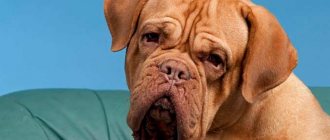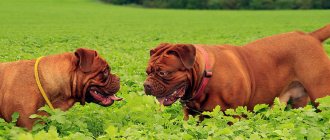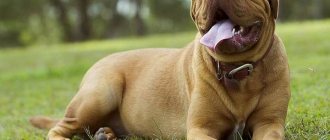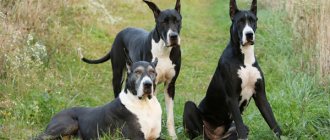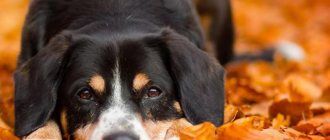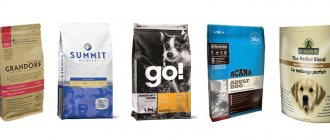The Dogue de Bordeaux or French Mastiff is a large, massive dog with an impressive appearance, but cheerful and good-natured. Capable of becoming a devoted and loving friend, as well as a faithful watchman or bodyguard. Dogues de Bordeaux were bred in the past as fighting and guard dogs. Although now there is almost no aggression left in their character, the breed is not recommended for beginners. These strong, fearless dogs have gained popularity due to their selfless devotion to their owner, calm disposition and formidable appearance. Before you get a French Mastiff, you should study the description of the breed, get acquainted with photographs and videos. Reviews from owners will help you understand the pros and cons of these dogs and the features of their maintenance.
- Head
- Education and training
- Hygiene procedures
History of the Dogue de Bordeaux breed
Dogue de Bordeaux
The origin of the Dogue de Bordeaux is considered a bone of contention among cynologists around the world: it is not known for certain who became the progenitor of the breed, and the debate still does not subside. Three theories are common among dog breeders. According to the first version, Great Danes originated from the fighting “French”, participants in bloody dog pits. Adherents of the second theory believe that the breed originated from bulldogs. The third version says that the genotype of dogs is directly related to Tibetan mastiffs.
The first theory became the most widespread: “Bordeaux” inherited their appearance from the ancient Alans, widespread among the Spaniards and French. These fighting dogs were described in detail by Gaston de Foix, who was fond of hunting and in the 14th century published an entire book where the Alan appears as one of the oldest hunting breeds in France. The grip of a powerful dog was commensurate with the grip of three greyhounds at the same time, so Alans were bred to bait wild boars and other large prey. At the same time, the animals were also suitable for guarding cattle, transporting skinned carcasses, and even for participating in the widespread bloodthirsty entertainment of dog pits.
All Great Danes in France were divided into three types. The differences between them were dramatic. There were dogs with a uniform color or points over the entire surface of the body, a small or large head, a straight or scissor bite... They contributed to the appearance of the modern breed.
For a long time, Dogues de Bordeaux were known as French Mastiffs. Everything changed in 1863. The animals were presented under their current name. A dog named Magent won, and this was the first step towards official recognition of the breed.
Inspired by their success, breeders began actively breeding dogs that at least vaguely resembled Great Danes. Each confidently asserted that it was in his nursery that purebred animals could be found. Despite the obvious similarity of Bordeaux dogs with bullmastiffs, the fact of their relationship was denied. However, most dog breeders argued the opposite: the British used Dogues de Bordeaux to breed similar animals.
Dogue de Bordeaux puppy
Purebred dogs still survive, albeit in negligible quantities. Breeder Euler managed to acquire a couple of representatives of the breed - a male Buffalo and a female Sultana. Since 1892, active work began on breeding purebred Bordeaux dogs.
Four years later, veterinarian Pierre Meignen, who led a group of breeders, presented the first breed standard, copied from the aforementioned Buffalo. While other breeders considered it necessary to recognize Great Danes exclusively with a dark “mask,” Meunien did not support this hypothesis. The veterinarian’s explanation was simple: these kinds of marks are a sign of breed inbreeding, so it is worth selecting dogs with a uniform color or with a “mask” of a brownish tint. Subsequently, Meignen encouraged the breeding of exclusively red Dogue de Bordeaux with undocked ears.
In 1910, a certain Mr. Kunstler also joined the activities of Pierre Meunien. Being a professional dog handler and a passionate dog lover, the man wrote a voluminous article about the Dogue de Bordeaux, using reliable documents and facts. Kunstler's portrait of the animal represented an expanded breed standard. Like Menien, the dog handler believed that the presence of a black “mask” on the face of a Bordeaux dog was unacceptable, since such a dog was not considered a purebred.
The first breed club was founded in 1924 under the leadership of A. Bare. The responsibility for restoring the breed's numbers after the events of the First World War fell on his shoulders. Two years later, based on Kunstler's article, Bare created a new standard.
The breed almost found itself on the verge of extinction after 1939-1945, when the number of dogs declined catastrophically. Since Dogues de Bordeaux were quite large animals, feeding them in wartime turned out to be an almost impossible task. Many dogs were killed or euthanized so as not to burden themselves with the additional “burden” of a hungry pet. Few breeders selflessly protected their charges. In the history of the Dogue de Bordeaux, the name of only one has been preserved - Mr. Van Capel, who did not leave the dogs to their fate.
This dreamy look...
Fortunately, French Aquitaine was practically unaffected by the bloody battles, and a few “Bordeaux” managed to survive. The dog handler Raymond Triquet was the first to undertake the restoration of the Great Dane in the 1960s. A. Bare again created a breed club. Despite the efforts of breeders, by 1966 only five purebred dogs were registered. During breeding, Dogue de Bordeaux puppies from a few litters lived at home with the breeders or their close friends.
The results of Triquet's organized activities became clear by 1970. Together with Maurice Luquet, the dog handler created the third standard. A year later, the FCI officially registered the Dogue de Bordeaux. In 1993, Monsieur Luquet again took up the creation of the standard - this time together with Philippe Serouy. At the same time, “The Saga of the Dogue de Bordeaux” was published in two volumes.
Over time, the breed became famous. Its representatives were widely imported to other states for further selection. "Bordeaux" were crossed with Japanese Tosa Inu, used to breed the Dogo Argentino and save the line of English mastiffs. Bordeaux dogs entered Russia in 1900. Among the imported Bordeaux dogs, Svetlana Dorogova's pet stood out - the handsome Belmondo, a world champion among his brothers. Three years later, he won in Moscow, where among 60 Dogues de Bordeaux, the jury members singled out Dorogova’s dog. Belmondo became an honorary participant in the Bordeaux breeding program and attracted public attention to his breed.
Appearance of the Dogue de Bordeaux
Nature has generously rewarded the Dogue de Bordeaux with an athletic build, good health and remarkable strength. Despite some squatness, the Bordeaux look harmonious, and the extravagant charm of the animals smoothes out their external roughness.
The standard provides for a certain height and weight of Dogues de Bordeaux. The height of males at the withers reaches 60-68 cm, their body weight is 50 kg and above. Bitches have other parameters: height is about 58-66 cm and weight is in the range of 45-50 kg. Sexual dimorphism is pronounced. Males are massive and heavy, and their character is more restless.
Head and skull
Sit down, let's go!
When viewing the dog from above, the trapezoidal shape of the head is noticeable; when looking at the animal from the front, it is square. The convex forehead is divided by a shallow hollow in the center. Folds radiate from it, which deepen when the Dogue de Bordeaux is excited. The brow ridges and cheekbones of the dog give noticeable volume to the skull.
Muzzle
The Bordeaux muzzle is slightly shorter than the forehead. Its distinctive feature is a “mask” that is a tone darker than the main color of the coat. The stop is sharply defined, almost a right angle. The wide lobe is upturned, but not flattened. The lips are fleshy and form an inverted “tick”. The chin is massive.
Ears
The small ears of the Dogue de Bordeaux are rounded, their tips barely reaching the outer edge of the eyes. Their high and wide (compared to each other) fit visually makes the dog’s skull more massive. The ears rise when the animal is excited and fit tightly to the cheekbones if the dog is alert.
Eyes
Set quite low. The color of the iris can be different: hazel or brown in dogs with a dark “mask” on the face, light brown in animals with a red “mask”. The last option is also typical for dogs with a complete absence of a “mask”.
Jaws and teeth
The Dogue de Bordeaux's lower jaw protrudes forward and rises slightly above the upper. The dog's incisors are set on the same line. Representatives of the breed are characterized by an underbite (bulldog bite).
Neck
The Dogue de Bordeaux's neck is cylindrical. The scruff is convex, connected to the wide withers of the animal. The appearance of the dewlap and dewlap is created by the folds of skin on the dog's throat.
Dogue de Bordeaux muzzle
Frame
Dogue de Bordeaux, rear view
The body of the “Bordeaux” is elongated and has a massive bone structure. The withers are elevated. The shoulder blades are pressed tightly. The back turns into a rather convex loin, and that into the sloping croup of the Great Dane. The chest is well filled. The rounded ribs are slightly flattened on both sides. The lower part of the chest meets the taut hemline.
Tail
It has a wide base and moderate length. Its tip is lowered to the animal's hock joints. When at rest, the tail hangs down, and when moving, it rises 100°.
Forelegs
They are distinguished by their particular massiveness in the shoulder area, which form a right angle with the shoulder blades. Elbows are pressed. The forearms and pasterns are vertical. The paws are strong, “equipped” with crowded toes and strong claws. The pads are elastic.
Hind limbs
Placed at a smaller distance from each other in comparison with the forelimbs. Developed muscles are noticeable on the wide hips of the dog. The joints are emphasized, the metatarsals are steep. The paws are slightly longer than the front ones, and there are no dewclaws. The claws are strong.
Movement style
Dogues de Bordeaux prefer to trot, but as speed increases, they begin to “creep” along the ground. The leisurely pace of the dog is characterized by ambling. In other cases, the movements are sweeping and elastic.
Dogue de Bordeaux in motion
Coat
The Dogue de Bordeaux's coat is short and thin, quite soft, and fits tightly to the dog's body. There is no undercoat.
Color
The breed standard allows for dark and light shades of brown. White points on the chest and fingertips are acceptable. The “mask” is a tone darker, may be black or absent. The latter case is characterized by a reddish or pink color of the nose.
Possible defects
Dogue de Bordeaux at a dog show
Any (even the slightest) deviation from the Dogue de Bordeaux standard is considered a breed defect. The most common:
- close bulldog, scissor or level bite;
- swaying of the croup in a vertical plane when moving;
- weak and rather stretched back and/or lower back;
- sharply tucked or straight abdominal line;
- undefined muscles of the limbs;
- close-set and/or round eyes;
- timidity and melancholy;
- heavy movements;
- loose physique;
- undeveloped jaws;
- hyperexcitability;
- elongated neck;
- small teeth.
Disqualifying faults of the Dogue de Bordeaux include:
- hunchbacked/sagging back and/or lower back;
- domed or bulldog-shaped head;
- barrel-shaped or flat chest;
- white points on the dog's head and body;
- aggressive or cowardly behavior;
- square or elongated body;
- large or small eye shape;
- atypical pigmentation of the iris;
- low or high neck position;
- excessive thinness or obesity;
- snoring when the animal moves;
- shortened upper lip;
- “femininity” of males;
- very short tail;
- undescended testicles;
- straight fangs.
Photo of Dogue de Bordeaux
Character of the Dogue de Bordeaux
The Dogue de Bordeaux's intimidating appearance is the main reason why people consider these dogs to be aggressive and dangerous. Once you discard stereotypes, the dog will appear different to you: playful, faithful and loving. There is no punishment worse for an animal than loneliness. Lack of attention negatively affects the behavior of Bordeaux, so do not be surprised if, upon returning home, you are greeted with damaged furniture, broken vases and an overturned bucket of water.
Dogue de Bordeaux with a child
Representatives of the breed are completely devoted to the family in which they live, and especially to their owner. Sitting down at your desk or sitting comfortably to relax on the sofa, don’t be too lazy to put your hand down: after a few minutes, your pet’s wet nose will definitely bury itself in it. As soon as you decide to leave the room, the dog will immediately follow you, no matter how sound and comfortable its sleep was.
The Dogue de Bordeaux behaves similarly on the street. When walking without a leash, the animal prefers not to stray far from its owner so as not to lose sight of him. To allow your pet to stretch its paws, take it for a light jog in a city park. This will not only cheer up the dog, but will also provide you with a little peace of mind in the evening: a tired Great Dane will take a place on his favorite bedding, and will not cause destruction in order to throw out pent-up energy.
"Bordos" cannot be called a family dog, but still he easily gets along with children over six years old. The fuss and noise of a younger child is perceived by the Great Dane as a potential threat. In addition, the huge dimensions of the animal make it quite dangerous: when passing by, a Dogue de Bordeaux may inadvertently push your child or fall on him during play. Dog handlers recommend postponing the purchase of a dog until the children go to school, but even in this case it is necessary to closely monitor the relationship that develops between the child and the Bordeaux. The slightest conflict should be nipped in the bud.
Cohabitation of a Great Dane with other pets is possible under certain conditions. A properly raised dog will not bare its teeth at its fellow dog, but the same cannot be said about male dogs, who most often develop competitive relationships with animals of the same sex. The Dogue de Bordeaux gets along quite easily with a domestic cat, but when it sees a stranger, it will certainly give chase and, most likely, will delight you with its “prey.” It is not recommended to let your Great Dane off the leash while walking if you do not want to become an accomplice in a bloody massacre. Representatives of this breed have an overly heightened hunting instinct, so you shouldn’t take risks, even if you are confident in the pet’s calmness.
A socialized Dogue de Bordeaux will not attack a stranger. The main thing is to treat the giant with respect and not bother him with unnecessary attention. Listen to your dog's grumbling: this is often a warning signal that may lead to an attack.
Representatives of the breed make excellent guards. “Bordeaux” will not allow entry into the territory entrusted to them without permission. Even when a stranger appears, the Great Dane will not immediately rush into pursuit. First, the animal will try to properly scare the unwanted guest with its menacing appearance and only then will it show strength. If it comes down to protecting the family, the Dogue de Bordeaux will fight to the last and will most likely emerge victorious.
An interesting feature of the dog’s character is its intolerance to the smell of alcohol. Refrain from walking your Dogue de Bordeaux during city festivities: meeting a drunk person can cause your pet to become irritable. Under certain circumstances, the Great Dane attacks, and it is quite difficult to restrain a dog of this size - even on a leash.
Dogue de Bordeaux with a cat
Dogue de Bordeaux with a small dog
Buying a puppy: price, documents, advice on choosing
When you have already chosen the Dogue de Bordeaux breed and decided to purchase a puppy, then, first of all, you need to decide what gender of animal you need and for what purpose you are making the purchase. As mentioned above, there are three exterior classes. The greater the compliance with the standard, the higher the price of the puppy will be. When choosing a dog among pet puppies, you do not need to show any special knowledge, the main thing is to have an idea of what a dog of a given breed should be like. If your attention is focused on choosing a dog of breeding and show classes, then you need to have a good knowledge of the standard. Dogs of these classes have a high cost, so knowledge of the standard will come in handy. It’s even better to get advice from an expert in the field of this breed in order to avoid mistakes and become a victim of deception. The most ideal option is to visit the nursery together with an expert.
What gender should I choose for my puppy? Here you make the choice yourself. When choosing a bitch, it is worth considering that they are very obedient, but they are not deprived of cunning; they should not be allowed to go for a walk without a leash during estrus, and this is at least 2 times a year. Leadership needs to be established over male dogs, which requires some effort. Also, male dogs often show dominance towards other dogs of the same sex, and when a female dog in heat is nearby, this worsens their behavior.
Dogue de Bordeaux puppies
Having chosen the gender of the puppy and made sure that it corresponds to the declared class, you can view the availability of nurseries of this breed and choose a responsible and conscientious breeder. This is a very important step towards purchasing a pet, because the quality of the breed depends on the qualifications and integrity of the breeder.
How can you find out how conscientious a breeder is? Here you can draw conclusions from a conversation with a person. The breeder will have a lot of questions for you, he will be interested in where and how the puppy will live, whether the owner can spend a lot of time with the animal, how much time the owner is going to spend walking the dog, that is, the breeder will be interested in: he needs to make sure that Will the puppy get into safe hands? The question may also arise about the room: how spacious, clean and light it is. The breeder will always be able to answer any questions from the buyer, provide the necessary documents, and advice on raising and feeding the puppy after purchase. The specialist will show the breeders and tell you about all the conformation deviations of the selected dog. All dogs have veterinary passports with age-appropriate vaccinations, done with a delay of no more than 10 days. No less important criteria for a good breeder are breeding no more than two breeds; puppies leave the nursery no earlier than three months of age.
Description of the Dogue de Bordeaux breed
Never purchase a puppy over the Internet if the owner only has photos and you have only talked on the phone. You definitely need to visit the nursery, or even better, more than once, to be sure of the integrity of the breeder and the quality of the breed. When visiting, look at the bitch, make sure that she is the mother of the puppy you want to purchase, look at the photo and video of the dog. Also review the documentation for the female and male (pedigree, diploma, veterinary passport, tests for dysplasia). You also need to review the documentation for the puppy so that everything is documented in the veterinary passport and puppy card. Be sure to examine the puppy before purchasing; it must be in excellent physical shape without psychological abnormalities. The animal should not be aggressive or injured. The puppy should be active and not overexcited. You need to get detailed advice from the breeder on the breed and find out about the health status of the animals in the nursery. Check the vaccination dates in your passport - do not pick up your puppy earlier than 10 days after vaccination, he must undergo quarantine.
Video - Description of the Dogue de Bordeaux breed
Puppy documents
The breeder is obliged, along with the puppy, to hand over a puppy card - a birth certificate (required by the Russian Canine Federation, without it it is impossible to register a pedigree in an international format) and a veterinary passport (availability of information on age-related vaccinations). Be sure to check that the name on the puppy card and the veterinary passport match!
This is interesting! The absence of a pedigree from the RKF completely excludes the possibility of participation in exhibitions of this organization and in performances at an international level.
Let us immediately inform the buyer: they do not immediately provide a pedigree with the puppy, this is due to the fact that the owner’s full name is indicated in the pedigree, that is, when you purchase the puppy, only then will it be possible to draw up this document.
If you purchase a puppy in another city, you must obtain an F1 certificate for hassle-free transportation of your pet on any transport. The buyer is also provided with a copy of the purchase and sale agreement and the acceptance certificate with signatures.
When choosing a puppy, be careful and carefully check all documents
Education and training
Dogue de Bordeaux training
Dogues de Bordeaux are distinguished by their quick wit and developed intelligence, but this does not at all make the process of education and training easier. Starting from puppyhood, it is necessary to teach your pet to treat people with trust. Regularly hold your baby in your arms and gently stroke his soft fur. In the Bordeaux consciousness, a person will be associated with positive emotions. However, you should not trust expressions of affection to strangers who do not know how to handle dogs.
Many owners of Dogue de Bordeaux note that puppies are most obedient at the age of three weeks. It is at this time that it is necessary to begin active education and accustoming the child to the rules of behavior. It is not recommended to stop training for a long period of time. What has been learned tends to be forgotten, especially as the Bordeaux grows older and new distractions appear.
From the very beginning, the Great Dane must learn a simple truth: there is only one leader in the “pack”, and it is not him. If you show a soft character, an older dog will create a lot of trouble. Representatives of the breed are quite capricious and know how to find weak spots in the “armor” of the owner. In addition, Dogues de Bordeaux are excellent manipulators, so they can soon begin to train you.
Train your pet to jump with its paws on its chest. It is unlikely that you will be happy when a 50-pound dog does this, and not an adorable puppy. Excessive intrusiveness is another character trait of the Dogue de Bordeaux that should be eradicated. Remember: the slightest indulgence on the part of any family member will nullify your attempts to raise a decent dog from your pet.
Dogue de Bordeaux puppy with owner
Representatives of the breed quickly learn what is required of them. Your task is to reward your pet at the right moments. You should not force the Dogue de Bordeaux: it will not help. It is much more effective to make the dog itself want to fulfill your request. There are many ways: a treat, an extraordinary walk in the park, or your pet’s favorite toy.
Training Dogue de Bordeaux is quite difficult. Along with an inquisitive mind, dogs are independent and stubborn, so learning a new command can take more than one day. The training should be consistent and short (no more than an hour). Don't raise your voice at your pet and reward his success with affectionate stroking or treats. Sharp shouts and rude orders are your main enemy: an upset animal gets lost and trains even worse. If your Dogue de Bordeaux is playing around, limit yourself to a stern reprimand, and then immediately reassure the dog by offering to repeat the command.
Dog breeders note that representatives of this breed often become lazy and slow. Don't scold your dog for thinking about commands for a long time. Once you win the respect and love of your four-legged friend, the training process will follow a well-trodden path!
An important point in training a Dogue de Bordeaux is walking on a leash. Don't let the puppy pull you forward! As the animal gets older, it will become more and more difficult to keep it. If your pet breaks the leash, pull him back, otherwise you will switch roles during the walk.
Caring for Dogue de Bordeaux
Bordeaux are not suitable for year-round outdoor or enclosure keeping, because a short coat will not warm you up in the cold season. Dogs will be most comfortable in an apartment or house, but the area should be sufficient for a large pet. Mastiffs do not need long walks and serious physical activity. Moreover, Great Dane puppies must even be limited in physical activity, otherwise disturbances in the development of the musculoskeletal system are possible.
It is best for Dogues de Bordeaux to live in an apartment or house.
Regular care is as follows:
- weekly combing with a special rubber mitten to remove dead hairs (during shedding, this is done more often);
- bathing as needed (about once every 2-3 months) using zoo shampoos for short-haired dogs;
- examining the eyes (daily) and ears (weekly), as well as cleaning them with veterinary lotions;
- trimming claws (monthly), if they do not grind down on their own;
- brushing your teeth with a special brush (finger attachment) and toothpaste that does not need to be rinsed off;
- cleansing and washing all folds on the face (after walks and meals) using a decoction of herbs or clean boiled water to avoid the accumulation of dirt and the development of infection.
You can feed Bordeaux dogs with factory-made freeze-dried formulas of at least premium class (Acana, Brit, etc.) or freshly prepared homemade food. Adults are kept on two meals a day; puppies are given food more often (3 to 6 times a day).
The unique dry food ACANA HERITAGE ADULT LARGE BREED for large breed dogs weighing more than 25 kg contains 60% meat ingredients, which makes the diet rich in proteins necessary for muscle development
To create a natural diet use:
- lean meat (veal, horse meat, turkey, etc.);
- offal and entrails (cartilage, tripe, kidneys, etc.);
- boiled fish (oceanic);
- raw and boiled eggs;
- fermented milk (cottage cheese, yogurt, etc.) with low fat content;
- boiled and raw vegetables;
- porridge (oatmeal, rice, etc.);
- fruits, greens;
- unrefined vegetable oil and vitamin and mineral supplements.
It is forbidden to give Great Danes pastries, canned food, sweets (especially chocolate), as well as smoked, fried, fatty and tubular bones (chicken, turkey, etc.).
The neighbors on the landing have a female Dogue de Bordeaux living in their apartment. She is now about five years old. When she was little, she was carried for walks in her arms so that her young bones would not become bent when going up or down the stairs. Towels are placed throughout all rooms to wipe away the drool that flows profusely from the mouth. The breed is very specific, but the character is really soft and friendly. I have never seen this dog growl or bark. It is enough for her to simply look from under her brows to intimidate any violator of the boundaries of her entrusted territory.
Training
You need to start raising a little Bordeaux as early as possible; kids quickly understand what is required of them and remember the simplest commands. Training can be a challenge because Bordeaux Mastiffs are stubborn, slow, and tend to be lazy. In addition, they quickly get tired of long lessons; the lesson should last no more than an hour. When working with this breed, consistency and constancy are important; training cannot be interrupted for a long time.
French Mastiffs need to be trained
It is recommended to use the help of an experienced instructor, but do not completely entrust the training of your pet to him, but only use professional advice.
Care and maintenance
This Dogue de Bordeaux loves to be hosed down
Short-haired dog breeds do not require painstaking care, and the Dogue de Bordeaux is no exception. The only thing you will have to tinker with is water treatments. These dogs love to wallow in the mud, so be prepared to bring home not a pet, but a huge and seemingly unfamiliar dirty dog. Dogues de Bordeaux are bathed as needed or twice a month. For washing, use zoo shampoo or its dry analogue (the latter is becoming increasingly popular among dog breeders).
In addition to bathing, you will have to wipe the Great Dane's face, and especially its folds, every day. Saliva and food often accumulate in them, since the animal eats extremely sloppily. Arm yourself with a dampened piece of fabric and carefully remove all excess from the folds on the face. This will help prevent unpleasant odors.
Caring for the Dogue de Bordeaux's coat is effortless. It is enough to wipe it with a cloth two or three times a week (to give it a healthy shine). During seasonal shedding, which occurs almost unnoticed, use a special mitten with silicone “growths”. They will delicately remove dead hairs from your pet's fur.
The Dogue de Bordeaux's ears tend to accumulate dust and dirt, thereby creating a favorable environment for the growth of bacteria. Your task is to prevent possible inflammation. Lift your ear and wipe it with a moistened cotton pad. To remove wax, use a cotton swab, but be careful: careless movement can damage the animal's eardrums! If you don't want to risk it, wrap your finger in gauze and do the same. The result will not be as effective, but safe.
Remember: an unpleasant odor, redness or a huge accumulation of wax is an alarming sign and a reason to contact a veterinary clinic.
Don't forget to inspect and clean your pet's eyes. For this procedure, use a cotton pad moistened with lightly brewed tea or warm boiled water. If excessive discharge in the corners of the eyes is an unhealthy color, make an appointment with your veterinarian. Your inaction in the future will create a lot of problems with the dog’s health.
Three heroes
The Dogue de Bordeaux's oral cavity requires no less care. Brush your pet's teeth three times a week using dog toothpaste and an old brush. You can also use a more budget-friendly option: wrap your finger in gauze and run it over your Bordeaux teeth. If your pet is acting restless, calm him down with gentle stroking and the promise of a treat after the “execution” is over.
The claws are shortened twice a month using a nail clipper. Use a nail file to remove sharp edges and burrs. Don't forget to thoroughly wipe your paws after a walk. If cracks or wounds appear, lubricate the pads with thick baby cream or antiseptic. It will not be superfluous to include sunflower oil in the Dogue de Bordeaux diet (no more than one teaspoon per day).
Important: wool treatment with anti-parasite agent and deworming should be carried out regularly - once and four times a month, respectively.
Oh, what a delicious cake!
The Dogue de Bordeaux is not prone to obesity with a balanced and properly selected diet. The more monotonous and “lighter” the food, the more smooth the dog’s digestion. With a natural diet, the basis of daily nutrition should be meat. It must be alternated with offal, sea fish and fermented milk products. From time to time, you can treat your pet to fruits and vegetables, and in winter, compensate for their absence with a complex of vitamins and minerals.
When using commercial food, purchase premium products, but remember to focus on options for large breed dogs. A visit to the veterinarian would be a good idea: he will tell you which food to pay attention to.
Eliminate Dogue de Bordeaux from your diet:
- river fish (including canned food);
- products containing caffeine;
- spicy and salty foods;
- mushrooms in any form;
- fruits with seeds;
- raw eggs and meat;
- legumes;
- yeast dough;
- tubular bones;
- fatty foods;
- onion and garlic;
- citrus;
- sweets.
There should always be fresh water in the dog's bowl - bottled or tap water, pre-infused for 6-8 hours.
Representatives of the breed need daily hour-long walks, especially in urban environments. During the hot season, give preference to morning and evening promenades: high temperatures cause Bordeaux to have hoarse breathing and shortness of breath. You can take a bottle of water with you and give your dog a cool shower for a few minutes when you get home.
If possible, take your four-legged friend out into nature to let him run around. Take your favorite ball and treat with you: repeating the learned commands in the fresh air is a great alternative to the usual training at home.
Dogues de Bordeaux are difficult to keep in an apartment. You will have to provide comfortable conditions, including active walks, so that the animal feels at ease and does not strive to release accumulated energy to the detriment of your interior.
Health and disease of the Dogue de Bordeaux
Ball! Give it here!
“Bordeaux” are distinguished by good health and are practically not susceptible to common diseases. At the same time, do not forget that adult dogs can boast of strong immunity. Unvaccinated puppies are vulnerable targets. It is not recommended to walk your baby outside until you have received all the necessary vaccinations.
Most often, Dogue de Bordeaux suffers from the following ailments:
- dysplasia of the elbow and/or hip joints;
- diseases of the cardiovascular system;
- respiratory infections;
- kidney diseases;
- volvulus;
- hyperkeratosis;
- flatulence;
- epilepsy;
- lymphomas;
- arthritis;
- cancer.
Bitches often experience difficult labor. Do not leave your pet and be ready to provide all possible assistance to her.
Dogue de Bordeaux mother with puppies
Common diseases
We have already said that very often these bumpkins suffer from obesity. You should not allow your dog to carry buns off the table and sleep 24 hours a day. If you don't have enough time for walks, it's better to choose a cat. In addition, hip dysplasia is often inherited, which is extremely difficult to treat. It is not uncommon to hear from a veterinarian about a case of epilepsy and various heart problems. These dogs rarely live longer than 8 years, so you will have to immediately prepare yourself for the fact that your pet’s life is finite. However, judging by the reviews, not a single owner regretted that the Dogue de Bordeaux was his choice. Reviews from the owners indicate that they never had a more intelligent and loyal friend.
How to choose a puppy
When planning to get a charming four-legged friend, decide on its class. Dogs in the “show” category can win the show because they best meet the breed standard. For animals of the breed class, minor deviations are allowed, but this does not prevent the dogs from being used for breeding. Dogues de Bordeaux of the pet class are typical pets, whose non-compliance with the standard does not allow participation in exhibitions or breeding programs.
The next stage is the sex of the animal. Bitches are more obedient, but they are not lacking in cunning and feminine cunning. Males are quarrelsome and independent, so you will have to show remarkable strength of character in dealing with them.
Now you can start looking for a trusted nursery. Before meeting the babies, ask the breeder to introduce you to their parents. Pay attention to possible defects: they can be inherited by puppies. It is equally important to check the necessary documentation: veterinary passport, pedigree diploma, test results for dysplasia. Only after this can you go to meet your future friend.
A healthy puppy is moderately playful and curious. The animal should not limp, whine for no reason, hide cowardly, show lethargy or excessive excitement. Carefully examine the baby and finally check the brand and nickname with his passport. Now you can start concluding a deal with the breeder.
Application
According to the current 1995 breed standard, the purpose of the French Mastiff is protection, guarding and intimidation. In this they are not inferior to fighting dogs .
Bordeaux dogs can be intimidating with their appearance alone; they do an excellent job of protecting a house or apartment, but they are categorically unsuitable for enclosure keeping.
These dogs show themselves best as companions: they are very human-oriented, always ready to accompany their owner on leisurely walks; in difficult times, a Bordeaux dog will sit next to you and sigh sympathetically - and this is the best psychotherapy in the world.
Photos of Dogue de Bordeaux puppies
How much does a Dogue de Bordeaux cost?
The price of a Dogue de Bordeaux depends on several factors.
Among the main ones is the class of the dog; location of the breeder; availability of documents confirming the origin of the animal. A pet-class Dogue de Bordeaux will cost the owner 40,000 rubles and more. For a purebred dog and, possibly, a future winner of the exhibition, you will have to pay 70,000 - 100,000 rubles. No matter how much you pay for a Bordeaux, know that you have acquired a devoted and loving friend who will always keep you company and make you smile even on the gloomiest day!
Owner reviews
Owners of the Dogue de Bordeaux believe that this is a wonderful, intelligent dog, it can be kept in small apartments, it does not require complex care, and the giant eats a little. These dogs are very loyal, always ready to defend their owner, so they are safe to walk with. The breed is mentally balanced, so there is no need for a muzzle, but it can be used in places as required. Also, Bordeaux dogs do not bark for no reason, they are quiet and calm: you will never see this dog barking loudly after a cyclist, a cat or other animals. The breed is very intelligent and devoted with all its soul to its family, however, this devotion must be earned, but in general it is not difficult.
The only drawback that most owners note is drooling.
These dogs are very loyal, always ready to defend their owner.

